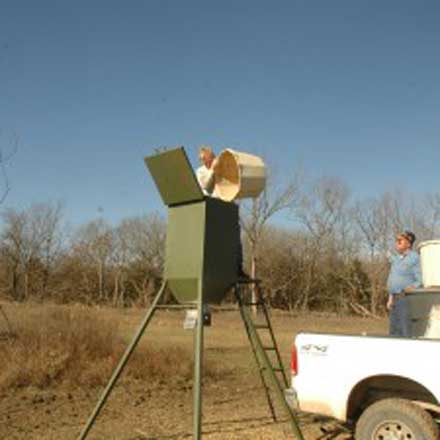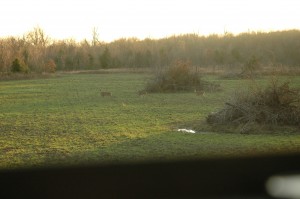
Some time back I used this space to discuss off-season scouting and some of the other preparations intended to make deer season as successful as possible. In Kansas, our rifle deer season is just 12 days, so it may seem like putting the cart before the horse to invest lots of time in food plots, stand preparation, and all the rest for such a short season. On the other hand, when the season is that short there isn’t much time to regroup or make new plans. Sure, you can always relocate a stand or put up a new one, but with just 12 days to play with, do you really want to go tramping around the woods, making noise, and leaving scent? Probably not, so you pretty much must have all your options in place on opening day—plans A, B, and more.
For the 2011 deer season just past, my neighbor, Chuck Herbel and I sort of pooled our resources. We spent a blazing hot week in August putting up tree stands, and for the most part, left them alone until the season rolled around. This has its pluses and minuses. In a perfect world, I think it’s wonderful to put in a stand and leave it alone long enough so it becomes a natural part of the environment. I don’t know how long this really takes, but I’m sure a few weeks are plenty! The down side is that, in August, it isn’t possible to know for certain what the whitetails are going to be doing in December!
So we made some assumptions that were correct and others that were flawed. On my place, I have a couple of stands way up in the woods on oak ridges that usually have a lot of buck activity. By August, I knew the acorn crop would be way down from the previous year, so I didn’t think either spot would be as hot as it has been. But I sure didn’t predict how ice-cold these locations would be! For instance, last year we had a record acorn crop, and on one frosty morning I saw more than a dozen bucks from one of these stands. This year, with very few acorns, I sat the same stand several times and saw almost nothing! On my place, that was Plan A, with other tree stands providing Plans B and C. I mixed things up depending on wind, weather, and pure whimsy, but Plan D was always my primary food plot sweetened by a corn feeder (which Kansas law allows).
So with time and effort in a big food plot, a comfortable tower blind, a feeder and corn to fill it with, why would such a setup be fourth down on my list of options? Well, for me it’s more fun to hunt the woods! Both the feeder and the...
winter wheat attract a lot of does, but in a post-rut environment, I don’t really expect frequent sightings of mature bucks in the open in daylight; the woods have been a bit more reliable. But it’s also a numbers game. The more deer you can see, the better and like all whitetail hunting, blind luck is important, but persistence also counts.

By the eighth day of the season, I’d accepted that the deer weren’t running my ridges like they usually do, and I’d fallen back on the food plot. Evening activity there is generally better than morning, and several days had passed since I’d seen any rutting activity at all…but you never know. It was well past nine when a half-dozen does trickled out onto the food plot, and after a short delay, a very nice eight-pointer followed.
My neighbor, Chuck, has a lot more ground than I do. He has a couple of well-sited tower blinds that have served well for a number of years, but for 2011, we put up five new Ameristep ladder blinds. We didn’t have any food plots, so most of the blinds were in known movement corridors to and from agriculture, and a couple of them were sweetened with corn feeders. I think we did a pretty good job of “prepping the ground,” but the truth is we don’t really know if all of the options were good because we had a couple of stands that nobody ever sat in at all.
This suggests that some of Chuck’s stands were red-hot, and indeed they were. On opening day, one great buck was missed on one ridge, and an even better buck was passed on a different ridge. These two areas remained hot through the season with multiple bucks sighted and a couple of good ones taken. Chuck’s acorns were no better than mine, so I have no idea why in this season just past, his oak ridges had more activity than my oak ridges, but deer movement is what it is. And while we may not always understand why deer prefer a certain area at a certain time, it’s always best to hunt where the deer are, not where we want them to be!
A friend of mine, Mike Hagen, came down from northern Missouri for the last few days of the season. I had my buck, so Mike had my whole place to himself. Early on, I’d passed a couple of...
reasonable bucks, so I wasn’t too worried. But Chuck’s hunters pulled out early on Thursday, and he called to tell me he still had a hot stand where several bucks had been working. Well, that sounded better than anything I had going, so we put Mike over there on Friday. Of course, he saw nothing in the morning, and again nothing in the evening. It must have crossed his mind that we were putting him on. He gave it one more try Saturday morning, and an ancient, downhill buck with massive antlers stepped out of some willows at the far end of a clearing.
That was the last buck of the 2011 season, and everybody who wanted a deer either took one or missed. In retrospect, Chuck and I figured we’d prepped the ground pretty well, but we’re still learning, and the whitetail is a great teacher. It will be interesting to see what 2012 brings.